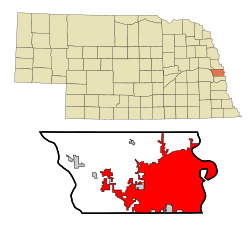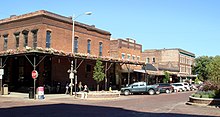Omaha
| Omaha | |
|---|---|
| Nickname : Gateway to the West | |
 Downtown Omaha from the east |
|
| Location in the state and county | |
| Basic data | |
| Foundation : | 1854 |
| State : | United States |
| State : | Nebraska |
| County : | Douglas County |
| Coordinates : | 41 ° 16 ′ N , 96 ° 1 ′ W |
| Time zone : | Central ( UTC − 6 / −5 ) |
|
Inhabitants : - Metropolitan Area : |
446,970 (as of 2016) 924,129 (as of 2016) |
| Population density : | 1,491.4 inhabitants per km 2 |
| Area : | 307.9 km 2 (approx. 119 mi 2 ) of which 299.7 km 2 (approx. 116 mi 2 ) are land |
| Height : | 332 m |
| Postcodes : | 68022, 68101-68164 |
| Area code : | +1 402 and 531 |
| FIPS : | 31-37000 |
| GNIS ID : | 0835483 |
| Website : | www.ci.omaha.ne.us |
| Mayor : | Jean Stothert ( R ) |
Omaha [ ˈoʊməhɑː ] is the largest city in the US state of Nebraska . It lies on the Missouri and is nicknamed Gateway to the West .
etymology
The city name is derived from the Indian tribe of the same name and means something like upstream .
geography
Geographical location
Omaha is located in eastern Nebraska on the western bank of the Missouri River , which forms the border with Iowa . A little further south, the Platte River flows into the Missouri.
climate
The mean mean temperature in Omaha ranges from −6.1 ° C (21 ° F) in January to 24.4 ° C (76 ° F) in July. Omaha lies in the continental temperate climate zone ( Dfa ) with hot summers and cold winters. Omaha is roughly at the same latitude as Rome , but due to the continental climate, the mean average winter temperature in Omaha is 7 ° C lower. The Weather Channel rated Omaha as the fifth coldest city of the 100 largest US cities, based on data for the past 30 years from December, January and February with an average temperature of −3.4 ° C (25.9 ° F).
| Omaha, Nebraska | ||||||||||||||||||||||||||||||||||||||||||||||||
|---|---|---|---|---|---|---|---|---|---|---|---|---|---|---|---|---|---|---|---|---|---|---|---|---|---|---|---|---|---|---|---|---|---|---|---|---|---|---|---|---|---|---|---|---|---|---|---|---|
| Climate diagram | ||||||||||||||||||||||||||||||||||||||||||||||||
| ||||||||||||||||||||||||||||||||||||||||||||||||
|
Average monthly temperatures and rainfall for Omaha, Nebraska
|
|||||||||||||||||||||||||||||||||||||||||||||||||||||||||||||||||||||||||||||||||||||||||||||||||||||||||
history
In 1804, the Omaha area was explored as part of the Lewis and Clark Expedition . The Kansas-Nebraska Act , signed on May 30, 1854, began the permanent settlement of the country. Omaha was founded on July 4th, 1854 and named after the Omaha Indian tribe who sold much of their land to the state. The city was on the path of prospectors who were attracted by the California gold rush of 1848-1854. Omaha was the capital of the Nebraska Territory , but lost its capital status to Lincoln in 1867 when Nebraska became the 37th state to join the Union. At first Omaha was only connected to the rest of the country by a steamboat line to St. Louis . The Pacific Railroad Acts designated Omaha as the eastern terminus of the First Transcontinental Railroad , which was completed in 1869. In that decade, the population grew from 1,883 in 1861 to 16,083 in 1870. With the completion of the Union Pacific Missouri River Bridge in 1872, Omaha was also connected to the eastern section of the American rail network.
Since the 1870s, the rapidly growing town has been a center of the meat processing industry. Massive race riots broke out in 1919 . Omaha has been a center of the African American civil rights movement since around 1940.
Became famous for Omaha both through the Wild West Show of Buffalo Bill and the end of the Second World War , as a part of the coast of Normandy in connection with the invasion in France ( Operation Overlord ) was named after him. The Omaha Beach section was one of the bloodiest scenes of this war.
Population development
| year | Residents¹ |
|---|---|
| 1950 | 251.117 |
| 1960 | 301,598 |
| 1970 | 364.929 |
| 1980 | 313,939 |
| 1990 | 335.795 |
| 2000 | 408,637 |
| 2010 | 432.003 |
| 2016 | 446.970 |
¹ 1950–2010: census results; 2016: US Census Bureau estimate

economy
The metropolitan area of Omaha generated an economic output of 61.3 billion US dollars in 2016, making it 52nd among the metropolitan areas of the USA and generating a significant part of the economic output of Nebraska. The unemployment rate in the metropolitan region was 2.8 percent and was thus below the national average of 3.8 percent (as of May 2018). The personal per capita income in 2016 was 53,613 US dollars, which means that Omaha has an above-average income level.
Omaha is the economic hub of the state of Nebraska . The city is home to several large, international companies. These include (in brackets the rank in the Forbes Fortune 1000 list 2016):
- Berkshire Hathaway (4th)
- Union Pacific Railroad (129th)
- Kiewit (314.)
- Mutual of Omaha (367.)
- TD Ameritrade (680.)
- Green Plains Renewable Energy (742.)
- Valmont Industries (813.)
- West Corporation (869.)
- Werner Enterprises (945.)
One of the city's best-known sons is the multibillionaire Warren Buffett (also known as: the Oracle of Omaha ), who runs his investment empire from Omaha with his company Berkshire Hathaway. Annual shareholder meetings are held at the CenturyLink Center .
Sport and culture
Omaha does not have a franchise from the four major American sports leagues ( Major League Baseball (MLB), National Basketball Association (NBA), National Football League (NFL), and National Hockey League (NHL)). From 1972 to 1978, the NBA franchise Kansas City-Omaha Kings (from 1975 Kansas City Kings , now the Sacramento Kings ) after moving from Cincinnati carried part of its home games in Omaha before the team moved all to Kansas City .
The Omaha Ak-Sar-Ben Knights ice hockey team , which played in the American Hockey League (AHL) from 2005 to 2007 , was based in Omaha and played in the Omaha Civic Auditorium . Omaha also has a junior ice hockey team from the USHL , the "Omaha Lancers".
The Joslyn Art Museum houses the most important art collection in the state of Nebraska. The Bemis Center for Contemporary Arts for artists in residence is located in the historic Old Market District , which was built in the 1880s . A lively music scene has developed since the 1950s.
The second largest university in Nebraska, the University of Nebraska Omaha with around 14,000 students, is based in Omaha. It is spread over three locations in the city.
Twin cities
-
 Braunschweig , Lower Saxony , "City Friendship" since 1992
Braunschweig , Lower Saxony , "City Friendship" since 1992 -
 Shizuoka , Japan
Shizuoka , Japan
-
 Šiauliai , Lithuania
Šiauliai , Lithuania
-
 Naas , Ireland
Naas , Ireland
-
 Xalapa , Mexico
Xalapa , Mexico
-
 Bachmut , Ukraine
Bachmut , Ukraine
-
 Yantai , People's Republic of China
Yantai , People's Republic of China
Personalities
Sons and Daughters of the City (selection)
- Fred Astaire (1899–1987), dancer, singer and actor
- Marlon Brando (1924-2004), actor
- Warren Buffett (* 1930), investor and multi-billionaire
- Montgomery Clift (1920–1966), actor
- Gerald Ford (1913–2006), 40th Vice President (from 1973 to 1974), 38th President (1974–1977) of the USA after the resignation of Richard Nixon
- Jaime King (born 1979), actress
- Lawrence Klein (1920–2013), economist and Nobel Prize winner
- Malcolm X (1925-1965), leader of the civil rights movement
- Nick Nolte (born 1941), actor
- Conor Oberst (* 1980), musician
- Andrew Rannells (* 1978), actor and singer
- Andy Roddick (* 1982), tennis player
- John Richard Sheets (1922–2003), Auxiliary Bishop of Fort Wayne-South Bend
- Elliott Smith (1969-2003), musician
- Nicholas Sparks (* 1965), writer
- Richard Stoltzman (* 1942), clarinetist
- Gabrielle Union (* 1972), actress and model
- Julie Wilson (1924–2015), singer and actress
- Jackson Withrow (born 1993), tennis player
Personalities who have worked on site
- Leisha Hailey (* 1971), actress and musician
- Orenda Fink (* 1975), musician
- Edward Flanagan (1886–1948), Catholic clergyman, founder of the youth welfare organization Boys Town and the homonymous suburb of Omaha, Boys Town
- John L. Watson (* 1951), chess player and author
Web links
Individual evidence
- ↑ a b c Harl Adams Dalstrom: Omaha. In: Encyclopædia Britannica . Retrieved October 3, 2019 .
- ↑ Omaha: Geography and Climate on city-data.com. Retrieved October 3, 2019.
- ↑ Milton W. Cole, David L. Goodstein, Angela D. Lueking: Science of the Earth, Climate and Energy. World Scientific , 2018. pp. 130, 138.
- ↑ Algis J. Laukaitis: How cold is it? Lincoln ranks 7th coldest in nation. In: Lincoln Journal Star . January 10, 2014, accessed October 3, 2019.
- ^ History of Omaha, Nebraska on omaha.net. Retrieved October 5, 2019.
- ^ US Department of Commerce, BEA, Bureau of Economic Analysis: Bureau of Economic Analysis. Retrieved July 4, 2018 (American English).
- ↑ Omaha-Council Bluffs, NE-IA Economy at a Glance. Retrieved July 5, 2018 .
- ^ US Department of Commerce, BEA, Bureau of Economic Analysis: Bureau of Economic Analysis. Retrieved July 5, 2018 (American English).
- ↑ Fortune 1000 Companies List for 2016
- ↑ Tom Shatel: Shatel: When we were Kings, or at least shared them . In: Omaha World-Herald . October 19, 2016, accessed October 5, 2019.
- ↑ 10 Largest US Markets Without A Major Pro Sports Team on thepostgame.com. June 15, 2016, accessed October 5, 2019.

